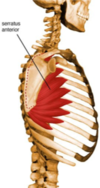Muscle Anatomy Flashcards
Origin and insertion of latissimus dorsi?
Origin: spinous process of T7 to LV and sacrum, iliac crest, ribs 10 to 12 Inserts: floor or intertubercular sulcus of humerus (anterior aspect of humerus) Posterior origin to anterior insertion
What movement does the lat dorsi allow?
- Extends humerus
- Adducts humerus
- Medially rotates humerus
Posterior origin to anterior insertion
Innervation of lat dorsi?
Thoracodorsal nerve (C6 to C8)
Photo of lat dorsi
f

Origin of pec major?

2 parts; clavicular and sternocostal part
Clavicular part: originates from anterior surface of medial 1/2 of clavicle
Sternocostal part: originates from anterior surface of sternum and costal cartilage of ribs 1-6
Insertion of pec major?
Both clavicular and sternocostal parts have same insertion point –> inserts on the (bicipital groove and deltoid tuberosity of the) humerus
I.e. clavicle and sternum to arm
What movement does the pec major allow?
- Flexion of humerus (e.g. throwing ball underhand) –> as clavicular fibres contract and pull humerus up
- Adduction of humerus (e.g. flapping arms) –> as fibres contract and pull the humerus towards the body
- Rotates humerus medially (e.g. arm wrestling)
Also keeps arm attached to trunk of body
Photo of pectoralis major

Origin of pec minor?

Anterior surface of ribs 3-5
Insertion of pec minor?
Coracoid process of scapula
I.e. ribs to shoulder blade
What movement does pec minor allow?
- Stabilises scapula
- Assists in protraction
- Pulls tip of shoulder down
- Retraction
- Elevates ribs for deep inspiration when shoulder girdle is fixed
Photo of pec minor

Origin and insertion of serratus anterior?

Origin: Lateral surfaces of ribs 1-8 or 9
Inserts: Costal surfaces of medial border of scapula
i.e. ribs to shoulder blade
What movement does serratus anterior allow?
- Protraction of scapula
- Assist in respiration when fixed shoulder girdle
Photo of serratus anterior

Origin and insertion of trapezius?

3 parts; superior, middle inferior trapezius
Extends from back of head and neck to shoulder.
Inserts:
- Lateral 1/3 of clavicle
- Acromion
- Spine of scapula
What movement does trapezius allow?
- Elevate scapula
- Retract scapula
- Depress scapula
Origin and insertion of levator scapulae?

Origin: Transverse processes of C1-C4 (cervical vertebrae in neck)
Inserts: Upper portion of medial border of scapula
Neck –> shoulder
Movement of levator scapulae?
Elevates scapula towards neck
Photo of levator scapulae

Origin and insertion of rhomboid major?

Origin: Spinous processes of T2-T5
Insertion: Medial border of scapula at spine of scapula
Origin and insertion of rhomboid minor?

Origin: Lower portion of ligamentum nuchae, spinous processes of CVII and TI
Inserts: Medial border of scapula at spine of scapula
What movement do the rhomboids allow?
Retraction of scapula (pulls it towards vertebral column)
Origin and insertion of deltoid?

Origin: Lateral 1/3 of Clavicle (clavicular part), Acromion (acromial part), Spine of Scapula (spinal part) - Mnemonic: ‘Deltoid helps you carry SACS’
Inserts: Deltoid tuberosity of humerus
What movement does deltoid muscle allow?
Photo of deltoid

Origin and insertion of teres major?

Origin: Posterior surface of inferior angle of scapula
Inserts: Anterior surface of humerus (intertubercular sulcus)
I.e. shoulder to arm
What movement does teres major allow?
Medial rotation and extension of arm at the glenohumeral joint (produces movements of the arm on the shoulder joint)
By contracting, it pulls the humerus posteriorly (extension) and rotates it medially towards the trunk (medial rotation).
Origin and insertion of teres minor?

Origin: Upper 2/3 of scapula
Inserts: Posterior surface of greater tubercle of humerus
What movement does teres minor allow?
Lateral/external rotation of arm at glenohumeral joint –> is a rotator cuff muscle


